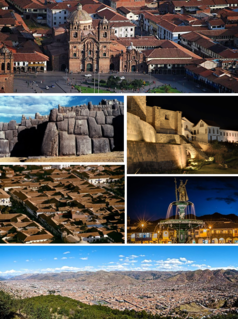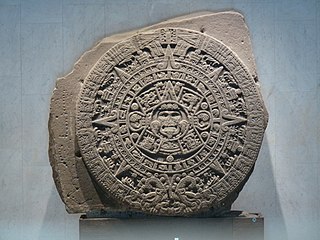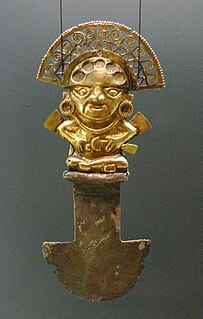
The Inca Empire, also known as the Incan Empire and the Inka Empire, was the largest empire in pre-Columbian America. Its political and administrative structure is considered by most scholars to have been the most developed in the Americas before Columbus' arrival. The administrative, political and military center of the empire was located in the city of Cusco. The Inca civilization arose from the Peruvian highlands sometime in the early 13th century. Its last stronghold was conquered by the Spanish in 1572.

Cusco, often spelled Cuzco, is a city in southeastern Peru, near the Urubamba Valley of the Andes mountain range. It is the capital of the Cusco Region and of the Cusco Province. In 2017, the city had a population of 428,450. Located on the eastern end of the Knot of Cuzco, its elevation is around 3,400 m (11,200 ft).

Machu Picchu is a 15th-century Inca citadel, located in the Eastern Cordillera of southern Peru, on a mountain ridge 2,430 metres (7,970 ft) above sea level. It is located in the Cusco Region, Urubamba Province, Machupicchu District in Peru, above the Sacred Valley, which is 80 kilometres (50 mi) northwest of Cuzco and through which the Urubamba River flows, cutting through the Cordillera and creating a canyon with a tropical mountain climate.

Pachacamac is an archaeological site 40 kilometres (25 mi) southeast of Lima, Peru in the Valley of the Lurín River. The site was first settled around A.D. 200 and was named after the "Earth Maker" creator god Pacha Kamaq. The site flourished for about 1,300 years until the Spanish invaded. Pachacamac covers about 600 hectares of land.

In the heterogeneous Inca Empire, polytheistic religions were practiced. Some deities, such as Pachamama and Viracocha, were known throughout the empire, while others were localised.

The Chimú culture was centered on Chimor with the capital city of Chan Chan, a large adobe city in the Moche Valley of present-day Trujillo, Peru. The culture arose about 900 AD, succeeding the Moche culture, and was later conquered by the Inca emperor Topa Inca Yupanqui around 1470, fifty years before the arrival of the Spanish in the region.

The Huaca del Sol is an adobe brick temple built by the Moche civilization on the northern coast of what is now Peru. The temple is one of several ruins found near the volcanic peak of Cerro Blanco, in the coastal desert near Ericka Trujillo at the Moche Valley. The other major ruin at the site is the nearby Huaca de la Luna, a better-preserved but smaller temple.

Huaca Rajada, also known as Sipán, is a Moche archaeological site in northern Peru in the Lambayeque Valley, that is famous for the tomb of Lord of Sipán, excavated by Walter Alva and his wife Susana Meneses beginning in 1987. The city of Sipán is dated from 50–700 AD, the same time as the Moche Period.

Pre-Columbian art refers to the visual arts of indigenous peoples of the Caribbean, North, Central, and South Americas until the late 15th and early 16th centuries, and the time period marked by Christopher Columbus' arrival in the Americas.

The Incas were most notable for establishing the Inca Empire in pre-Columbian America, which was centered in what is now Peru from 1438 to 1533, and represented the height of the Inca civilization. The Inca state was known as the Kingdom of Cuzco before 1438. Over the course of the Inca Empire, the Inca used conquest and peaceful assimilation to incorporate the territory of modern-day Peru, followed by a large portion of western South America, into their empire, centered on the Andean mountain range. However, shortly after the Inca Civil War, the last Sapa Inca (emperor) of the Inca Empire was captured and killed on the orders of the conquistador Francisco Pizarro, marking the beginning of Spanish rule. The remnants of the empire retreated to the remote jungles of Vilcabamba and established the small Neo-Inca State, which was conquered by the Spanish in 1572.
The Treasure of the Llanganates refers to a huge amount of gold, silver, platinum and electrum artifacts, as well as other treasures, supposedly hidden deep within the Llanganates mountain range of Ecuador by the Inca general Rumiñahui.

Coricancha, Koricancha, Qoricancha or Qorikancha was the most important temple in the Inca Empire.

Inti is the ancient Incan sun god. He is revered as the national patron of the Inca state. Although most consider Inti the sun god, he is more appropriately viewed as a cluster of solar aspects, since the Inca divided his identity according to the stages of the sun. Worshiped as a patron deity of the Inca Empire, Pachacuti is often linked to the origin and expansion of the Inca Sun Cult. The most common story says that he is the son of Viracocha, the god of civilization.

Tumi, is a generic term encompassing the many kinds of sharp tools utilized in pre- and post-colonial eras of the Central Andes region, Tumis were employed for a diverse set of purposes such as kitchen knives, agricultural tools, warrior or hunting secondary weapons, sacrificial knives, barber implements, pendants, or medical tools. In addition, the tumi form, in metal, was used as a type of coin. Pre-columbian Tumis were usually made of metal or stone.

The Museo Larco is a privately owned museum of pre-Columbian art, located in the Pueblo Libre District of Lima, Peru. The museum is housed in an 18th-century vice-royal building. It showcases chronological galleries that provide a thorough overview of 5,000 years of Peruvian pre-Columbian history. It is well known for its gallery of pre-Columbian erotic pottery.

The Museo de Arte Precolombino is an art museum in Cusco, Peru, dedicated to the display of archaeological artifacts and examples of pre-Columbian artworks drawn from all regions of pre-Columbian Peru. The museum is situated on Plaza Nazarenas in Cusco's San Blas district, and has on permanent display exhibitions of some 450 individual representative artifacts that are drawn from the wider collection of its parent museum, the Larco Museum in the Peruvian capital Lima.

Metallurgy in pre-Columbian America is the extraction and purification of metals, as well as creating metal alloys and fabrication with metal by Indigenous peoples of the Americas prior to European contact in the late 15th century. Indigenous Americans have been using native metals from ancient times, with recent finds of gold artifacts in the Andean region dated to 2155–1936 BCE, and North American copper finds dated to approximately 5000 BCE. The metal would have been found in nature without need for smelting techniques and shaped into the desired form using heat and cold hammering techniques without chemically altering it by alloying it. To date "no one has found evidence that points to the use of melting, smelting and casting in prehistoric eastern North America." In South America the case is quite different. Indigenous South Americans had full metallurgy with smelting and various metals being purposely alloyed. Metallurgy in Mesoamerica and Western Mexico may have developed following contact with South America through Ecuadorian marine traders.

Inca mythology includes many stories and legends that attempt to explain or symbolize Inca beliefs.

Intihuatana at the archaeological site of Machu Picchu is a notable ritual stone associated with the astronomic clock or calendar of the Inca in South America. Machu Picchu was thought to have been built c. 1450 by the Sapa Inca Pachacuti as a country estate, although it is equally likely that the Inca discovered much older ruins and opted to build this majestic estate on older foundations.. In the late 16th century, the Viceroy Francisco de Toledo and the clergy destroyed those Intihuatana which they could find. They did so as they believed that the Incas' religion was a blasphemy and the religious significance of the Intihuatana could be a political liability. The Intihuatana of Machu Picchu was found intact by Bingham in 1911, indicating that the Spanish conquerors had not found it.
Mama Killa, in Inca mythology and religion, was the third power and goddess of the moon. She was the sister and wife of Inti, daughter of Viracocha and mother of Manco Cápac and Mama Uqllu (Mama Ocllo), mythical founders of the Inca empire and culture. She was the goddess of marriage and the menstrual cycle, and considered a defender of women. She was also important for the Inca calendar.


























